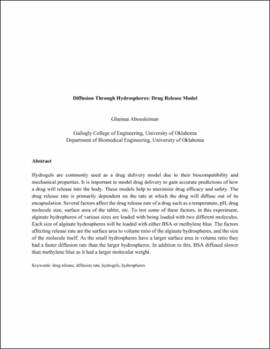| dc.contributor.author | Abousleiman, Ghainaa | |
| dc.date.accessioned | 2022-06-06T13:11:54Z | |
| dc.date.available | 2022-06-06T13:11:54Z | |
| dc.date.issued | 2022 | |
| dc.identifier.uri | https://hdl.handle.net/11244/335859 | |
| dc.description.abstract | Hydrogels are commonly used as a drug delivery model due to their biocompatibility and mechanical properties. It is important to model drug delivery to gain accurate predictions of how a drug will release into the body. These models help to maximize drug efficacy and safety. The drug release rate is primarily dependent on the rate at which the drug will diffuse out of its encapsulation. Several factors affect the drug release rate of a drug such as a temperature, pH, drug molecule size, surface area of the tablet, etc. To test some of these factors, in this experiment, alginate hydrophores of various sizes are loaded with being loaded with two different molecules. Each size of alginate hydrospheres will be loaded with either BSA or methylene blue. The factors affecting release rate are the surface area to volume ratio of the alginate hydrospheres, and the size of the molecule itself. As the small hydrospheres have a larger surface area to volume ratio they had a faster diffusion rate than the larger hydrospheres. In addition to this, BSA diffused slower than methylene blue as it had a larger molecular weight. | en_US |
| dc.language | en_US | en_US |
| dc.rights | Attribution 4.0 International | * |
| dc.rights.uri | https://creativecommons.org/licenses/by/4.0/ | * |
| dc.subject | drug release | en_US |
| dc.subject | diffusion rate | en_US |
| dc.subject | hydrogels | en_US |
| dc.subject | hydrospheres | en_US |
| dc.title | Diffusion Through Hydrospheres: Drug Release Model | en_US |
| dc.type | Article | en_US |
| dc.description.peerreview | No | en_US |
| ou.group | Dodge Family College of Arts and Sciences::Department of Biology | en_US |
| dc.description.undergraduate | undergraduate | |


